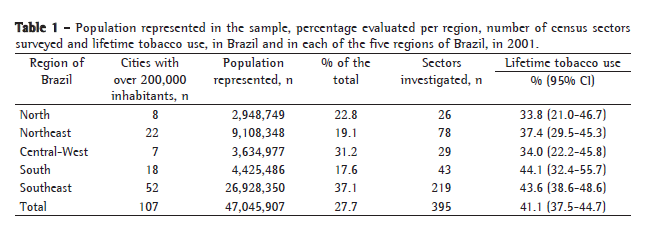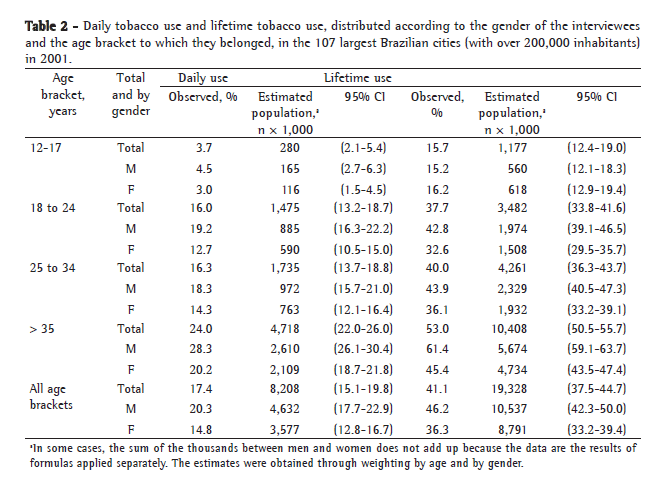

Fernando Sergio Leitão Filho, José Carlos Fernandes Galduróz, Ana Regina Noto, Solange Aparecida Nappo, Elisaldo Araújo Carlini, Oliver Augusto Nascimento, Sérgio Ricardo Santos, José Roberto Jardim
ABSTRACT
Objective: To provide access to the results of a randomized cross-sectional study conducted by the Brazilian Center for Information on Psychotropic Drugs in 2001. Methods: This survey involved a random sample of individuals ranging from 12 to 65 years of age and residing in the 107 largest cities (over 200,000 inhabitants) in Brazil, which represented 27.7% of the Brazilian population, estimated to be 169,799,170 inhabitants at the time. A total of 8,589 interviews were conducted. The Substance Abuse and Mental Health Services Administration questionnaire, translated and adapted for use in Brazil, was used in the interviews. Results: Of the sample as a whole, 41.1% of the interviewees reported having experimented with tobacco products. The prevalence of daily smokers was 17.4% (20.3% among males and 14.8% among females). We found that 9% of the sample (10.1% of the men and 7.9% of the women) were nicotine-dependent, according to the criteria of the National Household Survey on Drug Abuse. Conclusions: The prevalence of current smoking in the 107 largest cities of Brazil is significantly lower in this decade than was the national prevalence at the end of last century.
Keywords: Smoking/epidemiology; Tobacco use disorder; Smoking cessation.
RESUMO
Objetivo: Divulgar os dados de um estudo transversal randomizado, realizado em 2001, pelo Centro Brasileiro de Informações sobre Drogas Psicotrópicas. Métodos: A população pesquisada neste levantamento incluiu indivíduos com 12-65 anos de idade, residentes nos 107 maiores municípios do Brasil (com mais de 200 mil habitantes), o que representou 27,7% da população brasileira na época, estimada em 169.799.170 habitantes. Foram realizadas no total 8.589 entrevistas. Utilizou-se o questionário Substance Abuse and Mental Health Services Administration, que foi traduzido e adaptado para o uso no Brasil. Resultados: Do total, 41,1% dos entrevistados disseram já ter utilizado produtos derivados de tabaco alguma vez na vida. A prevalência de uso diário de tabaco foi de 17,4% da amostra (20,3% entre os homens e 14,8% entre as mulheres). Observou-se que 9% da população (10,1% entre os homens e 7,9% entre as mulheres) são dependentes da nicotina, segundo os critérios do National Household Surveys on Drug Abuse. Conclusões: A prevalência do uso diário de tabaco, nos maiores municípios brasileiros, é significativamente menor na presente década do que a prevalência nacional ao final do século passado.
Palavras-chave: Tabagismo/epidemiologia; Transtorno por uso de tabaco; Abandono do hábito de fumar.
Introduction

